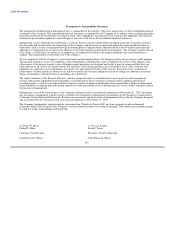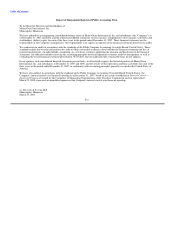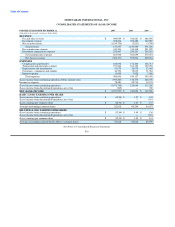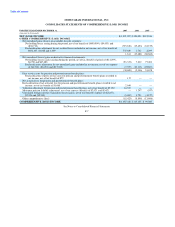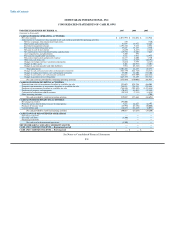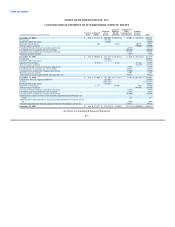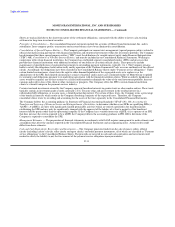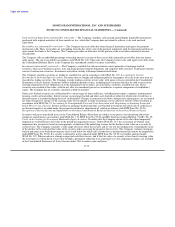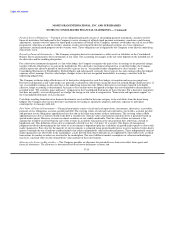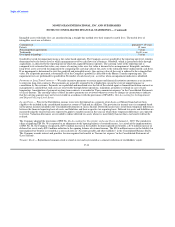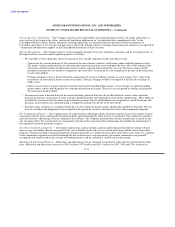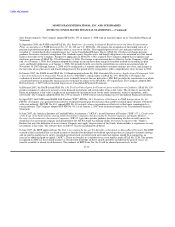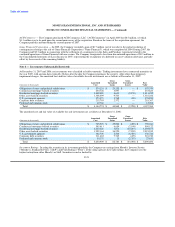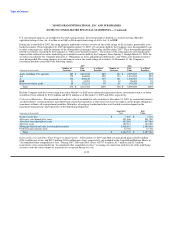MoneyGram 2007 Annual Report Download - page 86
Download and view the complete annual report
Please find page 86 of the 2007 MoneyGram annual report below. You can navigate through the pages in the report by either clicking on the pages listed below, or by using the keyword search tool below to find specific information within the annual report.
Table of Contents
MONEYGRAM INTERNATIONAL, INC. AND SUBSIDIARIES
NOTES TO CONSOLIDATED FINANCIAL STATEMENTS — (Continued)
Cash and Cash Equivalents (substantially restricted) — The Company considers cash on hand and all highly liquid debt instruments
purchased with original maturities of three months or less, which the Company does not intend to rollover, to be cash and cash
equivalents.
Receivables, net (substantially restricted) — The Company has receivables due from financial institutions and agents for payment
instruments sold. These receivables are outstanding from the day of the sale of the payment instrument until the financial institution or
agent remits the funds to the Company. The Company provides an allowance for the portion of the receivable estimated to become
uncollectible.
The Company sells an undivided percentage ownership interest in certain of these receivables, primarily receivables from our money
order agents. The sale is recorded in accordance with SFAS No. 140. Upon sale, the Company removes the sold agent receivables from
the Consolidated Balance Sheets as the Company has surrendered control over those receivables.
Investments (substantially restricted) — The Company's available-for-sale investments consist primarily of mortgage-backed
securities, other asset-backed securities, state and municipal government obligations and corporate debt securities. Trading investments
consist of auction rate securities. Investments are held in custody with major financial institutions.
The Company classifies securities as trading or available-for-sale in accordance with SFAS No. 115, Accounting for Certain
Investments in Debt and Equity Securities. Securities that are bought and held principally for the purpose of resale in the near term are
classified as trading securities. The Company records trading securities at fair value, with gains or losses reported in the Consolidated
Statements of (Loss) Income. Securities held for indefinite periods of time, including those securities that may be sold to assist in the
clearing of payment service obligations or in the management of securities, are classified as securities available-for-sale. These
securities are recorded at fair value, with the net after-tax unrealized gain or loss recorded as a separate component of stockholders'
equity. The Company has no securities classified as held-to-maturity.
Other asset-backed securities are collateralized by various types of loans and leases, including home equity, corporate, manufactured
housing, credit card and airline. Interest income on mortgage-backed and other asset-backed securities for which risk of credit loss is
deemed remote is recorded utilizing the level yield method. Changes in estimated cash flows, both positive and negative, are accounted
for with retrospective changes to the carrying value of investments in order to maintain a level yield over the life of the investment in
accordance with SFAS No. 91, Accounting for Nonrefundable Fees and Costs Associated with Originating or Acquiring Loans and
Initial Direct Costs of Leases. Interest income on mortgage-backed and other asset-backed investments for which risk of credit loss is
not deemed remote is recorded under the prospective method as adjustments of yield in accordance with EITF Issue No. 99-20,
Recognition of Interest Income and Impairment on Purchased and Retained Beneficial Interests in Securitized Financial Assets.
Securities with gross unrealized losses at the Consolidated Balance Sheet date are subject to our process for identifying other-than-
temporary impairments in accordance with SFAS No. 115, EITF Issue No. 99-20 and SEC Staff Accounting Bulletin ("SAB") No. 59,
Views on Accounting for Noncurrent Marketable Equity Securities. Securities that the Company deems to be other-than-temporarily
impaired are written down to fair value in the period the impairment occurs. Under SFAS No. 115, the assessment of whether such
impairment has occurred is based on management's evaluation of the underlying reasons for the decline in fair value on a security by
security basis. The Company considers a wide range of factors about the security and we use our best judgment in evaluating the cause
of the decline in the estimated fair value of the security and in assessing the prospects for recovery. The Company evaluates mortgage-
backed and other asset-backed investments rated A and below for which risk of credit loss is deemed more than remote for impairment
under EITF Issue No. 99-20. If a security is deemed to not be impaired under EITF Issue No. 99-20, it is further analyzed under
SFAS No. 115. When an adverse change in expected cash flows occurs, and if the fair value of a security is less than its carrying value,
the investment is written down to fair value through a permanent reduction to its amortized cost. Any impairment charges are included
in the Consolidated Statements of (Loss) Income under "Net securities gains and losses."
F-12


